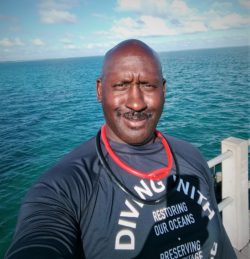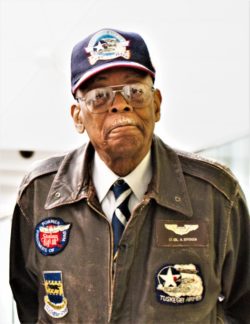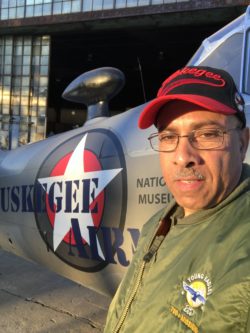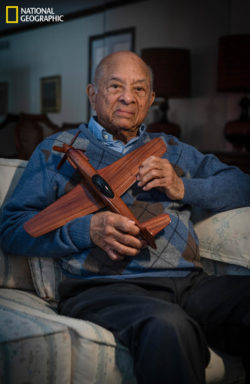Virtual discussion
Blue Beacon Series: Celebrating the Tuskegee Airmen
Celebrating the 80th Anniversary of the Tuskegee Airmen
For centuries, African Americans fought for greater roles in U.S. military conflicts, but quotas, exclusionary practices, racial discrimination and prevailing attitudes limited their participation. During the middle period of WWII, the ‘Tuskegee Aviation Experience’ was launched as the Army Air Corps program to train the nation’s first African-American military aviators to fly, fight, maintain combat aircraft and help win World War II (WWII). Recently, two WWII fighter planes were discovered in Lake Huron and the Saint Claire River that were piloted by Tuskegee Airmen who died during training accidents.
We invite you to join the National Marine Sanctuary Foundation, Diving With a Purpose, Detroit Historical Society, and National Museum of the Tuskegee Airmen in honoring the sacrifice, achievement, and heroism of these men and women of the Tuskegee Airmen. Our panel of experts will discuss the Tuskegee Airmen’s fight for equality, efforts to honor their service, and the importance of ensuring our maritime heritage represents the diversity of the American experience.
Join us on February 17th at 7:00 PM EST on Facebook Live (alternate stream embedded above on this page.)
About the Tuskegee Airmen
For centuries, African Americans fought for greater roles in U.S. military conflicts, but quotas, exclusionary practices, racial discrimination and prevailing attitudes limited their participation.
During the middle period of WWII, in 1941, as a result of political pressure from the black press, civil rights groups, historically black colleges and universities, and others, the ‘Tuskegee Aviation Experience’ was launched as the Army Air Corps program to train the nation’s first African-American military aviators to fly, fight, maintain combat aircraft and help win World War II (WWII). The group included: Pilots, Navigators, Bombardiers, Mechanics, Nurses, Crew Chiefs, Cooks and all support personnel who kept the planes and pilots in the air. The Tuskegee program trained almost 1,000 pilots who flew 1,578 missions and won over 850 medals. The formation of the Tuskegee Airmen and their stories demonstrate the struggles African American endured to serve in the U.S. military.
The Tuskegee Airmen were trained at Tuskegee Institute (University), in Alabama because of its pioneering commitment to aeronautical education and support of African-Americans in aviation endeavors. On March 26, 1943, the 332nd Fighter Group, comprised of the 100th, 301st, and 302nd fighter squadrons, departed Tuskegee Army Airfield (AAF), Alabama for final WWII combat crew training at Selfridge and Oscoda AAF’s; their new homes in Michigan.
Five aircraft piloted by Tuskegee Airmen, were lost due to training accidents in Michigan waters. Two fighter pilots training for deployment at Selfridge Field went down over the waters near Port Huron, Michigan. Flight Officer Nathaniel Rayburg died on Dec. 12, 1943 when he crashed into the St. Clair River near Algonac. Second Lieutenant Frank Moody died on April 11, 1944 when his plane crashed into Lake Huron. These aircraft have been discovered. Three additional aircraft flown by Tuskegee Airmen are still submerged and hidden in Lake Huron.
About our participants
 Dr. Justin Dunnavant, Academic Pathways Postdoctoral Fellow, Vanderbilt University’s Spatial Analysis Research Laboratory
Dr. Justin Dunnavant, Academic Pathways Postdoctoral Fellow, Vanderbilt University’s Spatial Analysis Research Laboratory
Dr. Justin Dunnavant is an Academic Pathways Postdoctoral Fellow at Vanderbilt University’s Spatial Analysis Research Laboratory and will be joining UCLA’s Anthropology Department as an Assistant Professor in the fall of 2021. His current research in the US Virgin Islands investigates the relationship between ecology and enslavement in the former Danish West Indies. In addition to his archaeological research, Justin is co-founder and President of the Society of Black Archaeologists, an AAUS Scientific SCUBA Diver, and consults for the Smithsonian’s National Museum of African American History and Culture.

Jay Haigler, lead instructor and safety officer, Diving with a Purpose
Jay received his initial Open Water training in 2005 through the Underwater Adventure Seekers (UAS) (www.uasdivers.org), the founding club of the National Association of Black Scuba Divers (NABS) (www.nabsdivers.org). Mr. Haigler became an Open Water Scuba Instructor in 2010. He continued his dive education by becoming certified as a Master Scuba Diver Trainer by the Professional Association of Diving Instructors (PADI). He was formally a National Oceanographic and Atmospheric Administration (NOAA) Scientific Diver. The purpose of the NOAA Diving Program is to train, certify and equip scientists, engineers and technicians to perform a variety of underwater tasks in support of NOAA missions.
Jay is currently the Diving Safety Officer for the Scientific Diving Program of the National Association of Black Scuba Divers Foundation. Having developed a strong interest in underwater archaeology, he immersed himself in a maritime archaeology program called Diving With a Purpose (DWP) (www.divingwithapurpose.org). Diving With a Purpose (DWP) is a volunteer underwater archaeology program which began under a partnership with the National Association of Black Scuba Divers (NABS) and the National Park Service (NPS) in Biscayne National Park located in Homestead, Florida. DWP performs extensive underwater archaeological documentation of shipwrecks; surveys their condition; and develops detailed maps of the wreck sites. In 2009, The United States Department of Interior awarded DWP with the “Take Pride In America National Award” in the Public Private Partnership category.
Jay has become a lead instructor with the program. A graduate of the Catholic University of America, with a Bachelor’s in Electrical Engineering, Jay enjoys the technical aspects of underwater archaeology, but his passion for teaching has paid dividends for many curious but reluctant prospects. Jay invests countless hours mentoring, training and honing the skills of new divers. As these men and women gain confidence in the water, Jay channels their enthusiasm and encourages their exploration of such meaningful diving pursuits as DWP and Youth DWP.
Jay is currently a director with Diving With a Purpose (DWP). DWP is a core institutional partner in the Slave Wrecks Project (SWP).

Lt. Colonel Alexander Jefferson, Tuskegee Airman
Alexander Jefferson, Lieutenant-Colonel USAF Retired, was born Detroit, Michigan, 15 November 1921. He is a graduate of Chadsey High School, Detroit; earned a Bachelor of Science Degree from Clark College, Atlanta, Georgia; conducted graduate work in Chemistry at Howard University Washington DC; and earned a M.S. of Education from Wayne State University,
Detroit.
In January 1944, Lt.-Col. Jefferson graduated from pilot training course at Tuskegee Army Air Field followed by three months of Combat Training at Selfridge Field, Michigan. He served as a P-51 fighter pilot with the Red Tail, 332nd Fighter Group, 301st Fighter Squadron in Ramitelli, Italy. In the course of providing protection from enemy aircraft, he flew 18 long range escort missions for B-17 and B-24 bombers. On August 12, 1944, three days prior to the invasion of Southern France, he was shot down by ground fire while strafing radar stations on the coast. Captured by German troops and interned for nine months as a prisoner of war, he spent the first five months in Stalag Luft III, 80 miles east of Berlin on the Odor River.
On January 29, 1945, when the Russians started their offensive, the prisoners, American, British and French, were transferred to Stalag VIIA, Mooseburg, approximately 20 miles north of Dachau. Liberated by American forces on the 29th of April 1945, he visited Dachau to witness the results of the atrocities committed by the Nazis.
He was discharged from active duty in 1947 and retired from the reserves in 1969 with the rank of Lieutenant Colonel.
Following the war, he became in an elementary school science teacher in the City of Detroit. He retired as an assistant principal in 1979. He is an active member of various church, educational and alumni organizations.
He is one of the founders of the Detroit Chapter of the Tuskegee Airman (which is the original chapter) and is a member of the Tuskegee Airmen Speaker Bureau.
As a Life Member of the Silver Falcon Association, he served on a voluntary basis as an Admissions Counselor for the United States Air Force Academy. He is a Life Member of American Ex-Prisoner of War and is a Perpetual Member of the Military Order of the World Wars. On October 14, 1995, he was enshrined into the Michigan Aviation Hall of Fame.
MILITARY AWARDS
Purple Heart Medal
Air Medal
Air Force Achievement Medal
POW medal
Air Force Presidential Unit Citation
American Defense Service Medal
American Campaign Medal
European-African-Middle Eastern Campaign Medal
World War II Victory Medal
National Defense Reserve Medal
Armed Forces Reserve Medal
Air Force Longevity Service Award
Bronze Star
Congressional Gold Medal
French Knight of the Legion of Honor Medal

Dr. Brian Smith, President, Tuskegee Airmen National Museum
Dr. Brian R. Smith is retired from General Dynamics Land Systems where he was instrumental in quantifying the injury tolerance limits induced by battlefield threats such as, mine blasts and improvised explosive devices (IEDs). His cutting edge research in this field has influenced the design of Combat Vehicles for the benefit of General Dynamics and the men and women of our armed forces.
Dr. Smith is a community leader involved with social, historical, and educational programs. Dr. Smith is the first African-American to earn a PhD in Biomedical Engineering at Wayne State University and has been recognized as such by the Michigan House of Representatives.
Brian has been a diligent and devoted member of the Tuskegee Airmen for more than 30 years. He is the son of a WWII POW. He currently serves as President and Treasurer of the Tuskegee Airmen National Museum, and is Director of Youth Programs for the Detroit Chapter of Tuskegee Airmen Inc., Brian uses his personal aircraft to support the programs and helps fly and maintain twelve aircraft at the Tuskegee Airmen National Museum.
He was a recipient of an Outstanding Civic Award from the Detroit Engineering Society, largely as a result of his work with Tuskegee Airmen youth programs. He also initiated and coordinates with Wayne State University the Aviation Career Education Academy and has initiated the Tuskegee Airmen National Museum Flight Academy, Detroit Tuskegee Airmen EAA Chapter 1351, Wild Blue Wonders Program, Tuskegee Airmen Glider Club, Tuskegee Airmen National Museum Rocket Club and Tuskegee Airmen National Museum Drone Program.
Brian was also Director of the Conant Cougars Pathfinders Club for 35 years, started and conducted a drum corps that traveled around the state leading parades, playing at rallies, basketball games, and at church events.
Dr. Smith frequently lectures on the Tuskegee Airmen speaking on their formation, combat experiences and what the Airmen contributed to America during and after WWII.
Dr. Smith resides in Detroit, teaches Math, Biology, Chemistry and Physics at Wayne County Community College and has flown over 1200 Young Eagles.

(Photo: Robert Clark/National Geographic)
Lt. Colonel Harry Stewart, Tuskegee Airman
Harry T. Stewart, Jr., Lt Col USAF (Ret), is a veteran of World War II, having entered the military service in March 1943. He was born on July 4, 1924, in Newport News, Virginia. During infancy his family relocated to New York City, where he attended both grammar and high school. At the onset of World War II, Stewart enlisted in the US Army Air Corps as an Aviation Cadet. After completing his flight training at Tuskegee Army Air Field, Alabama, and while still a teenager, he was awarded his pilots wings and commissioned a Second Lieutenant. After further flight training in P-40 and P-47 fighter aircraft, Colonel Stewart was assigned to the 15 th Air Force in Italy, where he joined the 332 nd Fighter Group, popularly known as the “Red Tails”. While in combat, Stewart flew 43 bomber escort missions in the P-51 “Mustang” fighter aircraft.
After the war ended, Stewart returned to the States and continued his military service as a fighter pilot until his discharge in January,1950. During WWII, he was credited with destroying three enemy aircraft in aerial combat, for which he was awarded the Distinguished Flying Cross. In 1949, he further distinguished himself as a member of the winning team of the first United States Air Force Fighter Gunnery Meet, also known as “Top Gun”.
Upon his discharge from the Air Force, Stewart returned to his hometown and enrolled in the New York University College of Engineering, and, was eventually awarded the degree of Bachelor of Mechanical Engineering. After graduation he became employed in various engineering executive capacities with such firms as, Bechtel Corporation in San Francisco, and ANR Pipeline Company in Detroit, the latter from which he retired as its Vice President of Administrative Services. During his employments, he also continued to maintain his military affiliation with the Air Force Reserve from which he subsequently retired at the rank of Lieutenant Colonel.
After civilian retirement, Stewart renewed his pilots license and gave frequent airplane rides to youth from the greater Detroit area under the sponsorship of the Tuskegee Airmen Historical Museum and the EAA Young Eagles program. Stewart is also subject of a current book, entitled- “Soaring To Glory: A Tuskegee Airman’s First Hand Account of Word War II”, authored by Philip Handleman.
Colonel Stewart currently resides in Bloomfield, Michigan.
About the Blue Beacon Series
The National Marine Sanctuary’s Blue Beacon Series aims to bring to light the ocean and Great Lakes’ biggest challenges through panels, lectures, and film screenings hosted around the country in order to build communities of support for marine protected areas. This series builds on the momentum of Capitol Hill Ocean Week, the nation’s premier conference on ocean and Great Lakes policy issues by bringing these important conversations into locally relevant contexts. For more information, visit marinesanctuary.org/bluebeacon.
Questions?
Please contact Jamie Smith, jamie@marinesanctuary.org or Ben Charo, ben@marinesanctuary.org
